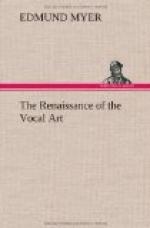More has probably been written and said upon this important question of breathing in singing than upon any other question in the broad field of the vocal art; and yet the fact remains that it is less understood than any of the really great principles of correct singing. This is due to the fact that most writers, teachers, and singers believe that they must do something—something out of the ordinary—to develop the breathing powers. The result is, that most systems of breathing are artificial; therefore unnatural. Most systems of breathing attempt to do by direct effort that which Nature alone can do correctly. Most breathing in singing is the result of direct conscious effort.
The conscious or artificial breath is a muscular breath, and compels muscular control. The conscious breath—the breath that is taken locally and deliberately (one might almost say maliciously) before singing—expands the body unnaturally, and thus creates a desire to at once expel it. In order to avoid this, the singer is compelled to harden and tighten every muscle of the body; and not only of the body, but of the throat as well. Under these conditions the first principle of artistic tone-production—the removal of all restraint—is impossible.
As the breath is taken, so must it be used. Nature demands—aye, compels—this. If we take (as we are so often told to do) “a good breath, and get ready,” it means entirely too much breath for comfort, to say nothing of artistic singing. It means a hard, set diaphragm, an undue tension of the abdominal muscles, and an unnatural position and condition of the chest. This of course compels the hardening and contraction of the throat muscles. This virtually means the unseating of the voice; for under these conditions free, natural singing is impossible. The conscious, full, muscular breath compels conscious, local muscular effort to hold it and control it. Result: a stiff, set, condition of the face muscles, the jaw, the tongue and the larynx. This makes automatic vowel form, placing, and even freedom of expression, impossible. The conscious, artificial breath is a handicap in every way. It compels the singer to directly and locally control the parts. In this way it is not possible to easily and freely use all the forces which Nature has given to man for the production of beautiful tone.
Now note the contrast. The artistic breath must be as unconscious or as involuntary as the vital or living breath. It must be the result of free, flexible action, and never of conscious effort. The artistic, automatic breath is the result of doing the thing which gives the breath and controls the breath without thought of breath. The automatic breath is got through the movements suggested when we say, Lift, expand, and let go.




